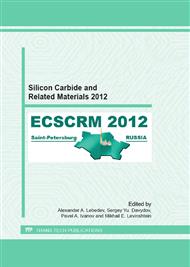p.841
p.843
p.847
p.851
p.855
p.859
p.865
p.869
p.873
Process Tolerant Single Photolithography/Implantation 120-Zone Junction Termination Extension
Abstract:
The multiple-zone junction termination extension (MJTE) is a widely used SiC edge termination technique that reduces sensitivity to implantation dose variations. It is typically implemented in multiple lithography and implantation events. To reduce process complexity, cycle time, and cost, a single photolithography/implantation (P/I) MJTE technique was developed and diodes with 3-zone and 120-zone JTEs were fabricated on the same wafer. Here, the process tolerance of the single (P/I) MJTE technique is evaluated by performing CCD monitored blocking voltage measurements on diodes from the same wafer with the 3-zone and 120-zone single (P/I) JTE. The 3-zone JTE diodes exhibited catastrophic localized avalanches at the interface between the 2nd and 3rd zones due to abrupt zone transitions. Diodes with the smooth transitioning 120-zone JTE exhibited no CCD detectable avalanches in their JTE regions up to the testing limit of 12 kV. Under thick dielectric (deposited for on-wafer diode interconnection), diodes with the single P/I 3-zone JTE failed due to significant loss of high-voltage capability, while their 120-zone JTE diode counterparts were minimally affected. Overall, the single (P/I) 120-zone JTE provides a process-tolerant and robust single P/I edge termination at no additional fabrication labor.
Info:
Periodical:
Pages:
855-858
Citation:
Online since:
January 2013
Authors:
Price:
Сopyright:
© 2013 Trans Tech Publications Ltd. All Rights Reserved
Share:
Citation:


